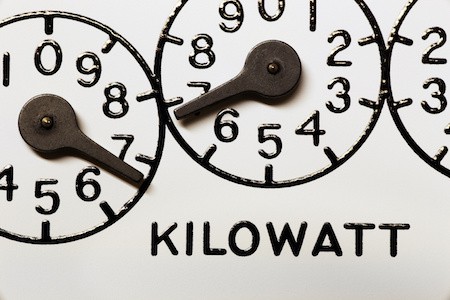When you think of the words “energy” and “power,” do you typically use them to mean the same thing?

These two terms are often used interchangeably, but they are quite different. Understanding the difference between these two terms is especially helpful if you have or are currently considering implementing a home solar system. That’s because solar systems use kilowatt hours, which are a form of energy but not a form of power.
What questions should you know about kilowatt hours? How can it influence your decision about whether or not to use solar panels for your home?
Common Questions:
- What Is a Kilowatt Hour?
- How Long Can You Run A Light Bulb On A Single Kilowatt Hour?
- What Is The Difference Between A Kilowatt Hour (kWh) And A Kilowatt (kW)?
- How Many Kilowatt Hours Does The Average Home Use In One Year?
- How Can Your Annual Kilowatt Hour Load Determine Proper Solar System Sizing?
- How To Use Your Cost Per Kilowatt Hour To Determine A Simple Solar Payback Period
What Is Kilowatt Hour?
A kilowatt hour, in its most basic form, is a unit of energy. It is most commonly used to measure the electricity that a business or household uses in everyday life.
When you look at your electricity bill every month, one of the determining factors in how much you pay your local utility is how many kilowatt hours you have used from the grid and the total energy cost of electricity kWh.
A simple electric bill calculator can help determine the electrical energy costs of your home. Additionally, solar energy is also measured in kilowatt hours.
One advantage to a solar system is that the electricity kWh cost is zero once the system is installed. For every kilowatt hour that a home solar panel system produces, this is one less kilowatt hour that you must pull from the grid and use to do things like turn on your lights and keep your refrigerator running. For example, if you have solar windows installed and they collect solar light as it travels through them, you can leverage their output to replace the other electricity costs in your home.
How Long Can You Run A Light Bulb On A Single Kilowatt Hour?

Let’s use the example of an average watt light bulb. The standard wattage of an average watt light bulb is around 60 watts. This means that if it were to run for one hour, it would use 60 watt hours of energy. One kilowatt hour of energy is equal to 1000 watt hours of energy. So, a standard wattage light bulb can run for almost 17 hours on a single kilowatt hour. Using a solar battery charger for small devices can help them run even longer, since solar batteries store electricity for later use.
For better energy efficiency, use LED bulbs; they can be as low as only 3 watts. A 3 watt LED bulb will operate for more than 333 hours on just a single kilowatt hour of energy. This same technique can be used to quickly identify the most energy-intensive appliances in your home so they can quickly be replaced so that your electric bills will quickly fall.
What Is The Difference Between A Kilowatt Hour (kWh) And A Kilowatt (kW)?
Power is different from energy. The most common unit of power for electricity is simply a watt unit of energy. One thousand of a watt unit of energy is a kilowatt. Energy is equal to a specific power multiplied by the time that power occurs. Consider power as instantaneous while energy happens over some predetermined set of time. For example, if a solar system rated at 1 kilowatt ran for one hour, it would produce 1 kilowatt hour.
Similarly, a 5 kilowatt home solar system that received eight hours of direct sunlight in a day could produce up to 40 kilowatt hours. To figure out the average power over a specified period, you can simply work the other way. If, for example, your home used 1000 kilowatt hours in a 30 day month, you could quickly solve for the average power (kW) in the month by dividing this energy usage by the total number of hours in a 30 day month (720). Therefore, the actual power consumption throughout the month is about 1.39 kW.
How Many Kilowatt Hours Does The Average Home Use In One Year?
Some of the cheapest states to live in often also have a very low cost of energy. This means these states are less impacted by lowering energy usage. In contrast, states with very high electricity costs may be more interested in reducing their cost through the use of an electric bill calculator. We will look at the average household in the United States for the purpose of this discussion.

On average, homes in the United States use roughly 10,400 kWh per year. This represents a monthly usage of just under 867 kWh. While this may seem like a high number, there are plenty of ways to lower that number, such as upgrading appliances for better electricity usage.
Additionally, suppose a homeowner was to generate their own power from a home solar system. In that case, they could reasonably expect to reduce this number by well over half, depending on the size of the array utilized. Energy is a commodity that is often taken for granted. By recognizing how valuable each kilowatt hour you consume is, you can quickly take steps to use fewer of them.
How Can Your Annual Kilowatt Hour Load Determine Proper Solar System Sizing?
The science of sizing solar systems to meet the full demand of a home gets better every year. To do this, solar experts will often look at your electric bills over the past few years from energy consumption meters if they are available. This will help them determine what your average load profile looks like. Suppose a homeowner is seeking to run their home exclusively on solar. In that case, the system must be sized to meet the homeowner’s demand in the worst solar production months, typically falling in the winter. This way, the maximum demand load is always met, and excess power in the summer can be exported to the grid in the summer and credited back to the customer if they live in a state which supports a net metering policy. Energy consumption meters keep track of all this to ensure you receive proper payment for overproduction.
How To Use Your Cost Per Kilowatt Hour To Determine A Simple Solar Payback Period
Once you have identified the average kilowatt hour cost on your electric bill and received quotes for a solar system, a simple calculation can figure out how long it will take for the solar system to pay for itself and yield a return. First, determine how many kilowatt hours your solar system is supposed to produce in one year. Then, multiply this value by your average kilowatt hour cost. These electrical energy costs will give you your total annual savings from utilizing solar power instead of power from the grid. You then divide the total cost of the solar system by the total annual savings to estimate your payback period in years. Any payback period for a solar system that is less than ten years is seen to be a good investment. No electricity offer will ever beat the “free” electricity a homeowner receives from a fully paid-off solar system. Note that many solar incentives can even further lower this payback period.

A kilowatt hour is far more than just one of the line items on your utility bill. It is the most basic form of energy and allows you to watch movies at home and use your stove for cooking dinner. Some of the cheapest states to live in may also be perfect for adding a home solar system. The electricity offer from the local utility will always be more than the cost of self-generated solar power. By better understanding what a kilowatt hour is, you can decide whether or not your family should begin to farm solar panels for electricity. By understanding the terms surrounding renewable energy, you take huge steps toward understanding your energy needs.
